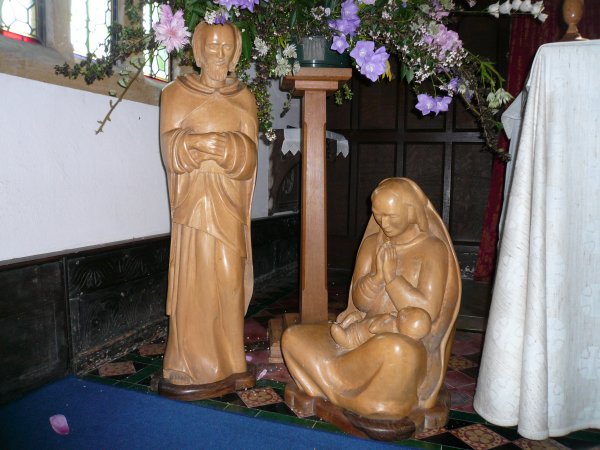The Font
It is impossible to estimate how many generations of villagers have been baptised in the octagonal font. Made from Ham stone in the Early English period, it was salvaged in two pieces from the churchyard when the Rev. Joseph Horrocks was Rector (1912-27).
All Saints Chantry Chapel
This small chapel on the north side of the nave is reached through a fine panelled arch of carved Ham Stone. It was built as a place where prayers and masses would be said for its founder after he had died. But it was being built at the time of the Reformation when people’s beliefs changed very radically. The new Protestant ideas prevented the Chantry being completed with statues. In 1912 a new roof replaced the old one at a cost of £11.92p.
Pulpit
Sermons used to be preached outside the church or in front of the Altar. In 1603 as more protestant ideas came in, it was ordered that every church should have a pulpit. This one is of the period, know as Jacobean it is of dark oak. The rich carving on it recalls Jesus saying, “I am the true vine, you are the branches”.
Wall Painting
In the corner behind the pulpit there are fragments of the original decoration of 1200. This was part of a sequence of large and colourful pictures which would have covered the walls. We do not know what scenes these fragments represent. If you are visiting the church, please resist the temptation to touch the paintings.
The Squint
The angled opening in the wall behind the pulpit was probably to enable worshippers in the original and wider nave to see the priest at the altar. Here and elsewhere tooling marks have been left on the stone. These diagonal marks are characteristic of masons in the Norman period.
The Holy Family
The figures of Joseph with Mary nursing the Infant Christ were carved for us by our village doctor (Dr. Noel Burrell) in the 1980’s, who captured the kicking position characteristic of small babies. The wood is laminated jelutong (Malayan gum).

The Chancel
The most interesting feature here is the East Window with its elaborate semi-circular arch – undoubtedly dating from the foundation of St. Mary’s in 1200.
Glass
There are some pieces of medieval glass in the Chantry windows. Other windows are mostly of Victorian coloured panes, making the church dark, contrasting with the clear light of the chantry chapel.
Memorials
Many of them give interesting details of village characters and their professions. Only two are commented upon here. Roger Bacon was born in Ilchester about 1214. A pioneer in careful observation and experiment he is often regarded as the father of English philosophy. His independent views challenged the assumption of his day. He became a Franciscan Friar (not a monk) in 1257 and died in 1292. The large brass tablet on the west wall was erected in 1914.
William Buckler
His memorial tablet is on the north wall of the chancel (by the choir stalls). He was Rector here for 40 years and died at the present Rectory in 1876 at the age of 66. He introduced into the parish a scheme of allotments, clothing and coal clubs as safeguards “… against the severities of winter, owing to the prevalence of ague and rheumatism consequent upon the flooded condition of the parish in wet seasons”.
Tapestry Work
The new kneelers, seat runners, and the Lectern Fall were all made by parishioners, men as well as women. They bring a rich variety of colour, design and symbol.
The Porch
The stones in the south wall are two 13/14th Century memorial crosses which were unearthed during the building work in 1880. When the Gas Board came to renew the gas supply in 1983 they were surprised to find that the wall here is 1.17 metres thick.
The Tower
50’ high, squat and octagonal, the tower is less ornate than other Somerset church towers. This one was added in the 13th Century before the boom in the wool trade made lavish ornament possible. It contains a ring of five bells, the heaviest weighing over half a ton. Details on the belfry door show that the bells were re-hung in 1938. Notice too the remains of medieval painting on the doorway arch.
Outside
Round the corner to your left as you leave, about ½ metre above the ground you will see a scratch dial. It used to be high on the south east wall of the nave before the new aisle was built. The usual markings for such dials show the times of services observed by Anglo-Saxon monks: Prime 7.00am, Terce 9.00am, High Mass 10.30am, Sext at noon, Nones 3.00pm, vespers 4.30pm, Compline 7.30pm.
The Pillar
Just outside the churchyard gate is one of several which supported the nave roof when the church was much larger.